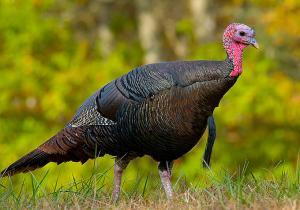Talking Turkeys for Thanksgiving
- posted: Nov. 18, 2017
 Talking Turkeys for Thanksgiving
Talking Turkeys for Thanksgiving
I’m not sure if our doctors have ever seen a turkey as a patient at Patton, but we have had ducks, chickens and a rooster named Bannie grace our exam rooms. I thought we’d have a bit of fun this week discussing America’s favorite holiday bird. Turkeys are popular this time of year, and approximately 44 million are served for Thanksgiving in the United States annually.
For your reading pleasure, here are five fun turkey facts:
- Did you know that turkeys are distant relatives of dinosaurs? The turkey’s fused collarbone called the furcular (better known as the wishbone) is a structure also found in the group of dinosaurs that include Tyrannosaurus Rex and velociraptors. Maybe watching Jurassic Park should be a new Thanksgiving tradition!
- Wild turkeys can fly for short distances at a speed of up to 50 miles per hour. Let’s hope they don’t fly into anyone’s windshield at that speed. Domestic turkeys are bred to be much heavier than their wild counterparts and are usually grounded for life. Ground feeders, they prefer to stay on terra firma, but wild turkeys will sleep in trees to avoid predators.
- The skin on a turkey’s head as well as the male’s wattle and that little fleshy snood that hangs over the beak can turn bright red during mating season or when the bird is frightened or excited. Turkey skin can also appear white or blue. And as for the traditional turkey call, only males actually produce that familiar “gobble gobble.”
- All birds have two parts to their stomachs: a glandular stomach and a gizzard. Turkeys and some other birds such as ducks, chickens, doves and emus have very thick muscular gizzards that contain grit or stones to help break down the food they eat. The gizzard is included as part of the giblets that are often packaged with our turkeys, so, if you make giblet gravy, you may be eating part of the turkey’s stomach this Thanksgiving!
- Turkeys have excellent vision. Because their eyes are on the sides of their heads, they have a nearly 360 degree field of vision by merely turning their heads. Turkeys also see in color and can spot movement nearly 100 yards away. They also have very good hearing, so it is difficult to ambush a turkey!
So, now we know a little more about the star of our Thanksgiving meal. Hope you enjoyed learning about turkeys. And, just a friendly reminder (we are a veterinary hospital after all!) please refrain from feeding turkey or other Thanksgiving favorites to your furry family members. Dogs and cats may become ill from eating turkey and other holiday foods. Make sure pets cannot get into the trash or access the turkey bones. Vomiting, diarrhea, pancreatitis or accidental ingestion of bones is NO fun for the holidays! If Aunt Edna does insist on feeding Dinky some turkey or Snots decides to counter-surf and eats the carcass, give us a call. We are open Friday for normal business hours 8AM to 8PM.
This blog brought to you by the Patton Veterinary Hospital serving Red Lion, York and the surrounding communities.
Turkey facts found at: https://www.livescience.com/17057-turkey-facts-thanksgiving.html
Location
Patton Veterinary Hospital
425 E Broadway
Red Lion, PA 17356
